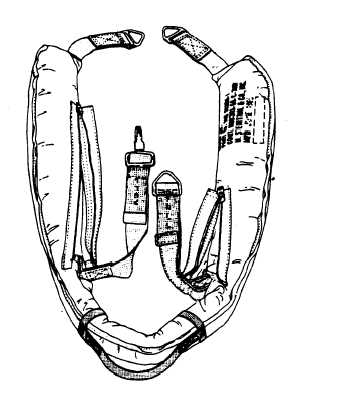NOTE: A static charge of electricity is built
up in the helicopter and must be dissipated
by grounding. Do NOT touch the rescue
device until after it has contacted the
ground or water to permit the discharge
of static electricity and prevent electrical
shock.
Research, development, test, and evaluation
of air rescue devices has been continuous since
the helicopter became the primary rescue vehicle.
The various types of rescue devices, their
functions, and associated maintenance procedures
are discussed in the sections that follow.
All helicopter rescue devices must be scheduled
into periodic maintenance under the direction and
control of the maintenance/material control
officer to which the equipment is assigned.
Maintenance must be thorough at all times. No
instance of careless treatment or willful neglect
of aircrew personal protective equipment will be
condoned. The vital function of the equipment
must be uppermost in the minds of all personnel
concerned.
Individual paralofts normally store and
maintain all helicopter rescue devices, and
checkout is on an individual basis. Because of the
lack of individual identification of the rescue
devices, it is impossible to match the Aviation
Crew Systems History Card to the rescue device.
All rescue devices should be locally serialized by
individual paralofts to ensure positive control of
inspection cycles performed on helicopter rescue
239.404A
Figure 5-13.—Survivor’s sling.
devices.
SURVIVOR’S SLING
The survivor’s sling is a buoyant device
consisting of a kapok filling encased in a bright
yellow waterproof cover to make it highly visible
during rescue operations. Webbing, reeved
through the cover with both ends terminating in
two V-rings, is used to attach the sling to the
helicopter rescue hook. Two retainer straps, one
long with a quick-ejector snap and one short with
a V-ring, are fastened to the webbing of the sling
and are enclosed in slide fastener-secured
envelopes. Refer to figures 5-13 and 5-14.
The survivor’s sling (also known as the “horse
collar” and rescue sling) is used to assist personnel
performing rescue work from a helicopter over
water or land. The survivor’s sling is lowered on
a hoist cable from a helicopter to the rescue
swimmer and survivor. The sling is designed to
239.404B
accommodate one survivor at a time.
Figure 5-14.—Survivor’s sling retainer straps pulled out.
5-13



